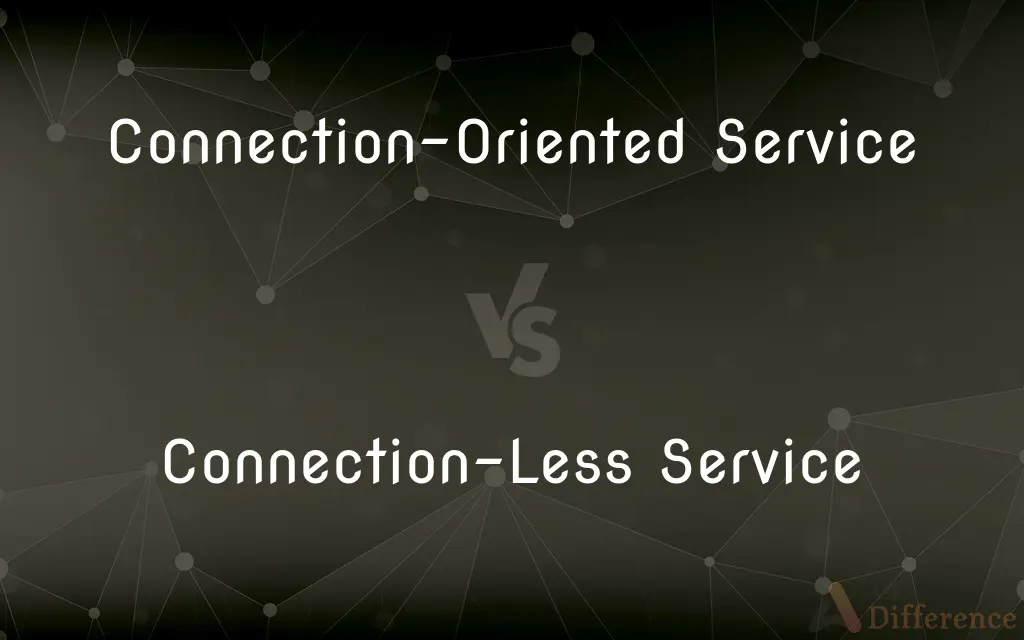Connection-Oriented Service vs. Connection-Less Service — What's the Difference?
By Urooj Arif & Fiza Rafique — Published on August 17, 2024
Connection-oriented service guarantees reliable, ordered data delivery through a pre-established path, whereas connection-less service sends data packets independently without a predetermined route, offering speed and efficiency for applications.

Difference Between Connection-Oriented Service and Connection-Less Service
Table of Contents
ADVERTISEMENT
Key Differences
A connection-oriented service is like making a phone call; there's a dedicated connection established between the sender and receiver before any data is exchanged. This setup ensures that data packets arrive reliably and in the correct order. On the other hand, connection-less service is akin to sending letters through the mail without tracking; each packet of data is sent independently, possibly taking different paths, and there's no guarantee they will arrive in order or even arrive at all.
In connection-oriented services, a significant amount of overhead is dedicated to establishing the connection, maintaining it, and ensuring data is correctly sequenced and error-free. This overhead includes handshakes, acknowledgments, and error recovery processes. Whereas, connection-less services minimize overhead by eliminating the need for a handshake before data transmission, reducing latency, and improving efficiency in environments where the network is reliable enough or the application can tolerate some loss of data.
The reliability of connection-oriented services comes at the cost of flexibility and efficiency. These services are less suited to environments with rapidly changing network conditions because the established path may not always remain optimal. Conversely, connection-less services excel in dynamic environments by allowing each data packet to independently find the most efficient route to the destination, enhancing overall network resilience and performance.
Flow control and congestion avoidance are integral to connection-oriented services, as the established protocols manage data flow to prevent network overload and ensure that all packets are delivered as intended. Connection-less services, however, largely leave these concerns to the endpoints, which may implement their mechanisms for dealing with lost packets, often through application-layer protocols.
While connection-oriented services resemble a traditional telephony system where the circuit's setup is crucial for communication, connection-less services mirror the postal system, emphasizing flexibility and efficiency over the guarantee of delivery. Each method has its ideal use case scenarios, reflecting the trade-offs between reliability, order, efficiency, and adaptability.
ADVERTISEMENT
Comparison Chart
Connection Setup
Requires setup of a dedicated connection before data transfer.
No setup required; data is sent directly.
Data Delivery
Reliable and ordered.
Unreliable and unordered.
Overhead
High due to connection setup, maintenance, and teardown.
Low, with minimal initial overhead.
Use Cases
File transfers, video streaming, where reliability is crucial.
Real-time applications, quick data exchange, where speed is prioritized.
Adaptability
Less flexible, struggles with changing network conditions.
Highly adaptable to changing paths and conditions.
Flow Control & Congestion
Integral part of the service, managed by the protocol.
Left to the endpoints, often managed at the application layer.
Examples
TCP (Transmission Control Protocol)
UDP (User Datagram Protocol)
Compare with Definitions
Connection-Oriented Service
Struggles in rapidly changing network environments.
TCP connections may deteriorate in mobile networks with fluctuating signal strength.
Connection-Less Service
Minimal overhead, enhancing performance.
DNS queries utilize UDP for quick resolution.
Connection-Oriented Service
Suited for applications where data integrity is critical.
Streaming services rely on TCP to prevent video corruption.
Connection-Less Service
Ideal for applications tolerating data loss.
Video conferencing apps use UDP to maintain real-time communication despite packet loss.
Connection-Oriented Service
Service requiring a dedicated connection before data exchange.
TCP ensures data packets are delivered in order and without error.
Connection-Less Service
Offers efficiency and speed for data transfer.
Live sports streaming uses UDP to minimize delay.
Connection-Oriented Service
Involves significant overhead for connection management.
Setting up a VPN connection for secure communications.
Connection-Less Service
Data packets sent independently without a preset path.
UDP sends voice packets in VoIP applications, favoring speed over reliability.
Connection-Oriented Service
Guarantees data delivery and order.
Secure financial transactions use TCP for reliability.
Connection-Less Service
Excellently adapts to dynamic network conditions.
UDP can quickly adjust to alternate routing in congested networks.
Common Curiosities
What is a connection-oriented service?
A networking approach that establishes a dedicated connection between sender and receiver before transmitting data, ensuring reliable and sequential data delivery.
Why choose a connection-oriented service?
For applications requiring guaranteed delivery and order of data packets, such as file transfers or video streaming.
How does a connection-oriented service handle network changes?
It may struggle with adaptation since the dedicated path might not remain optimal, potentially leading to decreased performance.
What is a connection-less service?
A method of data transmission where each packet is sent independently without establishing a dedicated path, focusing on speed and efficiency over reliability.
When is a connection-less service preferred?
In scenarios where speed is critical and occasional data loss is acceptable, like in real-time gaming or voice communication.
What makes connection-less service suitable for dynamic environments?
Its ability to send each packet independently allows for flexible routing, making it adaptable to network conditions.
What are the examples of protocols for each service type?
TCP is a standard example of a connection-oriented protocol, while UDP is a commonly used connection-less protocol.
Can you switch between service types during a session?
Generally, the service type is determined at the start of a communication session and remains consistent throughout.
How do applications compensate for the drawbacks of connection-less services?
Many implement their error-correction mechanisms at the application layer to handle lost or out-of-order packets.
Are connection-oriented services more secure than connection-less services?
The security of a service depends on additional factors like encryption and authentication protocols, not just the connection type. However, the predictable nature of connection-oriented services can facilitate the implementation of security measures.
Share Your Discovery

Previous Comparison
Coconut Sugar vs. Coconut Palm Sugar
Next Comparison
Classic Fit vs. Modern FitAuthor Spotlight
Written by
Urooj ArifUrooj is a skilled content writer at Ask Difference, known for her exceptional ability to simplify complex topics into engaging and informative content. With a passion for research and a flair for clear, concise writing, she consistently delivers articles that resonate with our diverse audience.
Co-written by
Fiza RafiqueFiza Rafique is a skilled content writer at AskDifference.com, where she meticulously refines and enhances written pieces. Drawing from her vast editorial expertise, Fiza ensures clarity, accuracy, and precision in every article. Passionate about language, she continually seeks to elevate the quality of content for readers worldwide.













































